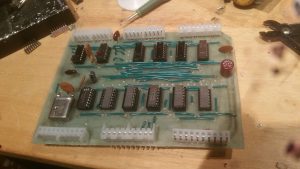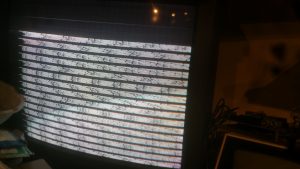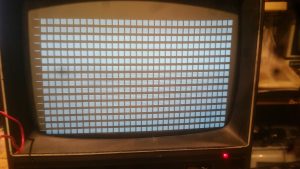Having successfully gotten (I think) a tune into the TV using the TVT’s sketchy RF modulator, the next stage is to put some actual integrated circuits to work and see if we can get this this puppy to do something interesting.
The construction guide advises that I need to completely build up the Timing board and part of Memory Board A (Page A), just enough on the latter to try and get something onscreen. Here’s the Timing board all dolled up and ready for action!
At this stage of construction, we are not yet adding the character generator, just IC 10 (a PISO generator) and IC 11 (an open collector NAND gate). First, the TVT should establish 32 columns and 16 rows of boxes as the field where text would appear. Then, with everything sort of floating open, it should set each of those boxes to be fully on, meaning we’ll have 512 of them on screen together if it all works.
After a few very careful checks for solder bridges, I stack the two boards into the motherboard, and go for it. And….
Nada.
No boxes, nothing onscreen. I check pin 20 on the system bus (the composite video out pin) for voltage, and it has it. I then decide to connect a composite monitor directly and bypass the TV for now, just to be a bit more certain that what I’m not seeing isn’t due to the RF modulator playing games. But there’s nothing there.
On the advice of Chuck from VCFED, I start digging into the timing board circuitry. First, we want to make sure there’s an actual clock signal happening, otherwise nothing at all will function. We’re looking at the MC4024 ‘dual astable’ chip used in conjunction with the crystal to create our system clock. Based on pinouts and the TVT schematic, I should be seeing something on the XTAL (crystal) pins of that chip, pins 3 and 4. But all is silent. My logic probe indicates no pulse activity at all.
Mystified, I start probing around the chip with the logic probe. I’m really scratching my head. Is it a bad chip? Maybe.. these things are 40+ years old and failure is always an option. I swap one of my precious spares in. Same thing. I swap the other spare in. Nope. So I’m really scratching my head here trying to figure out what the heck is going on. Chuck’s concerned I might have gotten the wrong 4024 – there is a CD4024 made by TI and Fairchild – similar part number, but very different chip. I verify mine are Motorola MC4024s. Did I get a bad bunch? Certainly possible. But not likely. I get back to basics and look for voltage at pins 1 and 14. Without adequate power (+5V), nothing much is gonna happen. I find 5V at pin 14 but *not* at pin 1. Hrmm.
It turns out after an hour of puzzlement that part of the answer is at hand. As I look more closely, I realize that I have goofed! I failed to solder in one end of a jumper (dang blasted jumper wires!) that should have connected 5V to the trace leading to that pin. Soldering it in, I now have 5V.. but still nothing on screen when I power up. Argh! Thought that would do it.
More headscratching and investigation ensues, before it dawns on me that my IC socket might be a problem. Thus far, I have been conducting my voltage test from the socket pins on the backside of the board. Now it dawns on me to check from topside. Sure enough, although voltage is getting to the socket pin, it is *not* getting to the actual pin 1 of the MC4024. Aha! After testing things a bit, I realize something is broken in the socket. This was a hazard of using vintage sockets of dubious provenance. To test things out, I connect pin 1 and 14 via a jumper, and now I have something on both my monitor and TV:
https://www.youtube.com/watch?v=8KgEkFfdaTs
Yay! Sort of. What’s onscreen *kind of* looks like boxes. But not nice, bright white boxes. It’s the same on composite… so it’s not an RF modulator issue. I’m going to get rid of this socket and replace it obviously since something’s borked on pin 1. I’m advancing, an inch at a time.
I keep probing around and find more problems. Pin 1 of IC9 (a 7402) on the timing board isn’t connected properly. I resolder that and now I have a signal there I didn’t, but still no change on screen.
Next I notice pins 3 and 4 on IC9 aren’t showing anything. The soldering looks ok and socket itself seems ok, so I swap to another 7402. Now i’ve got activity on those pins, but still no change onscreen. Agh! So frustrating!
Chuck suggests that I need to check pin 45, the character clock pin. I check it, but there’s no pulse there, so that indicates no dots are getting shifted out to the screen.
His next suggestion is to really check out those Signetics N8288s. These are very old divide by 12 counters that were a Signetics-only part and went extinct not long after their introduction. Chuck warns that the manufacturing processes used on these were not quite dialed in back in the early 70s, and it’s quite possible these have just degraded and died over the course of 40 something years.
I probe these ICs carefully following clock signals around. The probe’s speaker changes tone and the pulse speeds up or slows down depending on where I’m probing, as the clock is being divided progressively further and further. I’m scratching my head again – it looks like the 8288s are working just fine. However that proves to be incorrect. One of the 8288s, in IC2, is getting an inconsistent, flaky signal at pin 5 and 6. I notice if I press on the pin itself with my logic probe with a little bit of pressure, I get signal. As soon as I let the pressure off, nothing. I decide to (again) replace a socket, hoping the replacement works, as my stock of vintage sockets is dwindling fast.
That doesn’t solve the problem although now those pins are getting a much better signal. I keep digging around and eventually find IC9 is still not working correctly. I pull the board out and shine a bright light from on side so I can see the traces clearly on the other. It turns out I’ve accidentally bridged pins 2 and 3!
I make the correction, inspect the board one more time, and then do a literal Plug’n’Pray hoping I’ve found it. To my amazement and delight, this happens!
The RF modulator has dialed itself out a bit again but it’s clear from what I can see that we’ve finally got something to light up on screen. Connecting to the much clearer composite, it’s confirmed! I now have my boxes!
Wow. That was epic!
So I’ve learned a few things. One, if you’ve built it yourself, assume ‘user error’ is at fault before assuming your ICs or components are the issue. With traces, IC pads and the like packed in so tightly together, it is very easy, especially for a novice like me, to accidentally connect things that aren’t meant to be connected with solder, or not even solder them at all! Double, triple and quadruple check your work. Employ some form of illumination under your boards to really verify that you’ve got everything in order.
Further, be wary of sockets – especially vintage sockets. Even if unused, the quality of these varies and they do degrade over time, depending on how they are stored. Never assume because everything looks okay that it is. Check each and every pin on your IC with the pins on your socket and make sure they are actually connected!
And of course if you’re lost, it’s good to have the ‘phone a friend’ option. The vintage computing forums and email lists are fantastic for this. Everyone is so helpful and kind (and understanding!). Chuck’s expertise was invaluable here as it told me what to look for. It’s all a learning process.
I’m so impressed this thing is actually doing something! I honestly didn’t think I’d get this far. Okay, on to the next step!



